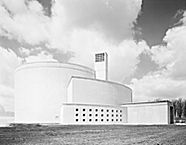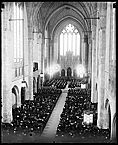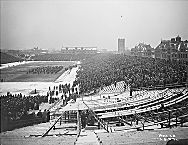| Entries |
| U |
|
University of Chicago
|

|
Retail merchant Marshall Field donated 10 acres in Hyde Park for the campus and later sold additional lands as the university expanded. Architect Henry Ives Cobb designed the Gothic revival campus in the image of Oxford and Cambridge, with the enclosed quadrangles creating a feeling of insularity and detachment from the surrounding city. The board of trustees hoped the design would foster a tight-knit community of scholars.
The university initially drew students primarily from the Midwest; most were children of small merchants and professionals. Women, many in graduate school, constituted over half of the students by the first years of the twentieth century. This generated concern among many trustees and administrators, who considered limiting women's admissions or ending coeducation altogether. Alumnae and faculty members successfully lobbied for women's continued access to the university.

|
To expand of the university's role in the city, President Harper launched the University Extension Program, modeled on the British program and on the American Chautauqua movement. Nonenrolled students, particularly adults in other parts of the city, could take courses part-time and off-site. Harper also sought university affiliation with other institutions in the city, including Rush Medical College, the Chicago Theological Seminary, and the Chicago Manual Training School.

|
Departments in the physical sciences gained distinction throughout the 1940s and 1950s. In 1942 a team of scientists led by physicist Enrico Fermi initiated the first self-sustaining nuclear reaction under the football stands at Stagg Field, as part of the Manhattan Project. Research in subatomic physics provided a new partnership between the federal government and the university that shaped the future of scientific research.
After a postwar boom in student enrollment, applications declined in the 1950s, largely as a result of changing neighborhood conditions in Hyde Park. Economic and demographic changes, particularly the increasing presence of African Americans in Hyde Park, led many white residents to leave the neighborhood. Many property owners subdivided homes and became absentee landlords, often neglecting building upkeep and maintenance. To revitalize the neighborhood, the university worked with local residents to create the Hyde Park– Kenwood Community Conference in 1949. Members promoted urban renewal policies to address issues of crime, poverty, racial integration, and planning. Several thousand residents were displaced in the process, but the partnership between the university and local residents became a model for promoting interracial and economically stable urban communities.
The University of Chicago's international stature is symbolized by the large number of faculty who have won Nobel Prizes. The university maintains a strong presence in city affairs and public policy and provides expertise in areas as diverse as legal aid, tax policy, housing, education, and medicine.
The Encyclopedia of Chicago © 2004 The Newberry Library. All Rights Reserved. Portions are copyrighted by other institutions and individuals. Additional information on copyright and permissions.